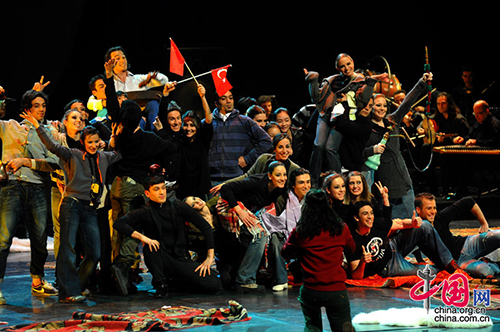
The Year of Turkish Culture in China (2013) was formally inaugurated in March after a curtain-raising gala in Beijing. Various cultural activities are on display or will be staged in different cities throughout China, ranging from opera, concerts and ballet to photo and painting exhibitions, according to the Ministry of Culture and Tourism of the Republic of Turkey.
The year-long cultural exchange is expected to enhance friendly relations between China and Turkey and is a part of the Joint Statement of the People’s Republic of China and the Republic of Turkey on Establishing and Developing Strategic Relations of Cooperation. Last year saw the Chinese Cultural Year successfully held in Turkey. What can Chinese audience expect from the Year of Turkish Culture? China Today sat down with Mr. Murat Salim Esenli, Turkish ambassador to China, to find out.
China Today: Mr. Ambassador, could you expound upon the importance of holding Chinese and Turkish culture years in each other’s country?
Ambassador Esenli: First of all, I would like to express my congratulations on the success of the Year of Chinese Culture in Turkey (2012). This was indeed a great collaboration between our two countries. On March 21 this year, the opening ceremony of the Year of Turkish Culture was held in Beijing’s Poly Theater and the Turkish Minister of Culture and Tourism Omer Celik was there to cut the ribbon. All these cultural activities were designed to enhance our traditional friendship by introducing Turkey’s past and present to the Chinese audience. Historically, our two nations were very close, but it is necessary for us to refresh the relations today and rediscover each other.
Leaders and government heads of our two countries reached mutual understanding in improving the traditional friendship between Turkey and China and, thus, in 2010 the two governments signed some cooperative agreements, including the one to hold cultural years in each other’s country. The cultural activities over the past year have achieved remarkable results. For example, people of both countries are paying increasing attention to one another, and the number of exchange students is rising steadily. Of course, mutual understanding cannot be reached merely through holding a cultural year. We are considering regular cultural exchanges in the future.
China Today: The schedule of the Year of Turkish Culture in China (2013) has shown carefully chosen content from Turkey’s colorful culture, which is greatly anticipated by the Chinese audience. What considerations were made when these activities were arranged?
Ambassador Esenli: Yes, you may have found this is a well thought-out collection by just watching the performances at the opening gala. According to my knowledge, choice of these activities was based on three considerations: they should represent the Turkish cultural tradition, reflect modern development and also reveal elements that Turkish and Chinese cultures share. I wonder if you have noticed the logo of the Year of Turkish Culture in China, which is actually a Turkish gown with a cloud pattern on it. In Turkey’s textile and design industry this pattern is popularly known as the “Chinese cloud.”
What also needs to be mentioned here is that for a long period the Turkish and Chinese people communicated mainly through a third party. At present, thanks to the rapid development of bilateral relations, people in our two countries can exchange information and views directly, enabling us to introduce ourselves more objectively.
